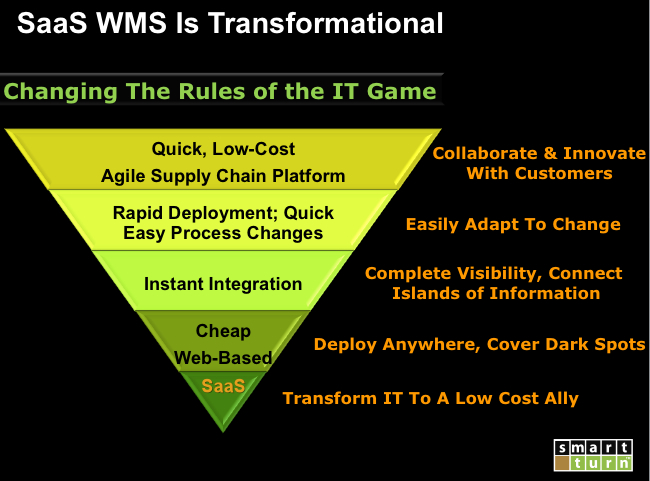Smart Turn: blowing up inventory management cost


Inventory and warehouse management is at once complex and costly, especially for tier 2 companies that have limited resources. An Aberdeen Group report published in late 2007 identified significant gaps in performance between best in class that make good use of technology to keep labor costs down and what they term the 'have nots.' An important barrier to adoption has been the high cost of traditional solutions. SmartTurn addresses this problem with a simple pricing model of $500 per warehouse per month, regardless of users and the functions they need.
That may sound too one dimensional to be successful in a world where we are accustomed to seeing multi-tier pricing but in the world of warehouse management software, (WMS) it makes perfect sense. It is impossible for instance to know with certainty how many users will be required for a given environment and therefore per seat pricing isn't a viable option. Per warehouse pricing is much easier to understand yet also allows customers to share information with anyone they need to without hitting a licensing problem.
Burleigh asserts that the WMS market of today resembles the CRM market of 1999, a time when he was employee number six at Salesforce.com. The industry analysts have yet to be convinced there is enough uniformity in the market to allow for a saas offering but as Burleigh says: "With over 100 customers and 30 employees, we've proven them flat out wrong." SmartTurn has addressed naysayers early concerns by providing a strong interface to bar-code readers, a staple tool in the warehouse environment.
SmartTurn won't be suitable for very large facilities. Instead, it is positioning itself for networks of facilities that are likely to be 200,000 square feet or less operated by the lower half of tier two down to tier four operators. It is what SmartTurn calls the 'dark spot' in the supply chain, that traditionally exhibits low levels of automation. Industry wise, it is better on the sell side of logistics and in discrete manufacture and FMCG.
SmartTurn solves the problem of communications within the network of tier two to four facilities by point and click permissions granting. That means the outbound shipment from one warehouse automatically becomes the inbound shipment to another in the network. At a stroke, this eliminates much of the errors that arise where manual systems are deployed."That's a natural by-product of having a multi-tenant system," says Burleigh.
At a more general level, I was concerned to discover how SmartTurn plans to make the saas model work, given the nature of the solution is more attuned to a traditional sale with RFP's, bag carriers and the like.
Burleigh and Yim insist the model works well because they can afford to turn to prospects and offer then a 30 day trial for free. "We'd rather let them try the software for themselves than go through some 50 or 100 page RFP. At this level, it either suits them or it doesn't," says Burleigh. Yim adds that: "Many companies we come across are frustrated they cannot get access to the technology so having a saas offering at $500 a pop with nothing to install, it's easy for them to get going. Right now we're growing organically within large companies too. There is so much unattended need out there we can have a very good business with what we're offering."
I like what SmartTurn is doing. This is a piece of the supply chain pie that has long been ripe for a radical injection of innovation, especially for the beleaguered tier two and under players. Attending to the basics that WMS should address with a saas model that tears down the barriers to adoption while offering collaborative opportunities is a great place to be. It sucks cost out at the point where the chain is mostly likely to be stressed. That's genuine goodness and always welcome.